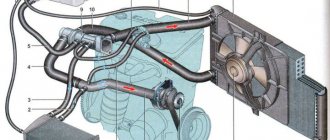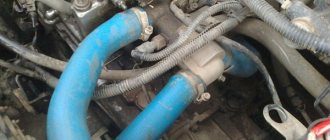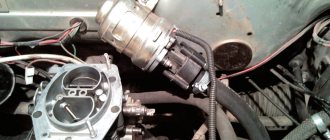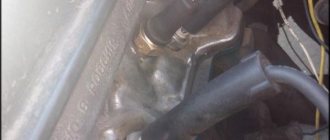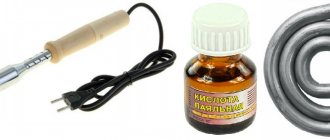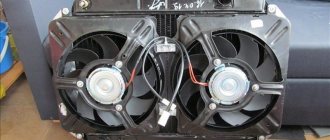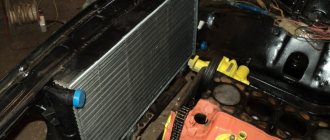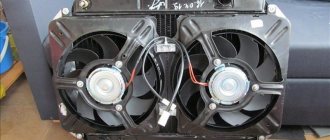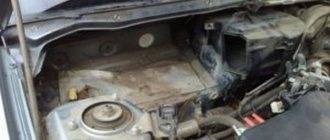The design of the cooling system of all cars, including the VAZ 2107, uses pipes. These are lines that connect system elements and ensure the transportation of coolant. Coolant flows through the tubes, so their main condition is tightness. The reason for the leakage of the cooling system of the VAZ 2107 may be the pipes, the specifics of replacing which we will look into in the material.
The stove blows slightly warm air
Every owner of a VAZ classic has probably encountered this phenomenon, because all big problems begin with small ones.
However, even with diagnostics, things are not so simple here, because there can be many reasons why warm or cold air is blowing from the VAZ 2101-2104 stove.
For example, due to the fact that the heater fan motor rotates much slower than the nominal operating mode. This malfunction is a consequence of oxidation/contamination of the collector. Cleaning the commutator brushes or completely replacing the electric motor are possible repair options.
Bearing jamming usually leads to the same results - it is diagnosed by the appearance of creaks from the side of the stove, which intensify over time, up to the jamming of the armature shaft.
The second common reason why the VAZ-2101 stove heats poorly is insufficient warming up of the engine. If the temperature gauge needle does not rise to the required 90 degrees, it can be assumed that the thermostat is jammed, and in a position where coolant is constantly circulating through a large circuit. In this case, you will need to replace the thermostat, which can be done independently on a penny:
- you need to work with a cooled power unit installed on a level surface;
- unscrew the plugs of the main radiator and expansion tank;
- pour the antifreeze into a previously prepared container of suitable volume (about 3 liters);
- tighten the drain plug;
- Using a flat-tip screwdriver, loosen the clamps of the pipes connected to the thermostat;
- dismantle the thermostat;
- We replace it with a known working one;
- We carry out all other work in reverse order.
After the coolant is added to the norm, we start the engine and monitor how the thermostat behaves by feeling its pipes - the lower one should remain cold until the engine warms up to 85-90 degrees.
Heater air duct VAZ-2101
Another common reason why the VAZ-2101 stove does not heat is contamination of the stove radiator. As a result, the heat transfer of the device is sharply reduced (which is facilitated by both the deterioration of antifreeze circulation and the decrease in heat transfer due to the adhesion of scale and other contaminants on the external and internal walls of the tubes).
How do you know if a clogged radiator is to blame for the lack of heat? It’s very simple: with the engine warm, check the inlet and outlet hoses by touch. If the first one is hot, and the second one is much colder, it is obvious that heat loss occurs precisely in the stove radiator.
It can be revised, but it is better to replace it with a new one - the decision is made after its dismantling based on the results of the inspection.
Here is the algorithm for dismantling the “kopek” stove:
the user instructions recommend draining the antifreeze, but in this case, due to the loss of a small volume of liquid, this may not be done (no more than a liter of antifreeze will spill out); from the engine compartment side, loosen the clamps on the radiator flanges and pull off the pipes
You need to work carefully - the hoses usually stick, and it will take a lot of effort to remove them; unscrew the cover of the rubber seal and dismantle it; go to the interior, unscrew the screws holding the car radio panel (if any); loosen the fasteners for the heater faucet drive, disconnect the cable; unscrew the brackets securing the fan casing; we move the casing down and to the left - it will not be possible to completely dismantle it due to the electrical wiring; we take out the stove radiator from the casing.. VAZ-2101 stove fan
Heater fan VAZ-2101
Now you can begin a thorough inspection of the radiator, as well as the stove faucet. If the tubes have traces of through or almost through corrosion, further inspection can be stopped - it will not be possible to repair such a radiator.
If the condition of the radiator is more or less tolerable, you can try to clean it using store-bought or “folk” remedies.
We also check whether the faucet handle is stuck - this usually happens if the stove has not been used for a long time (it has not been turned on throughout the warm season). We replace the faucet if traces of leakage are also found on its surface.
When installing a new or restored radiator, do not forget to install new gaskets, which can be pre-lubricated with silicone - this will prevent possible leaks. We perform the same operation in relation to the rubber pipes connected to the radiator. Add the required amount of antifreeze and check the operation of the stove, as well as the tightness of all connections.
Basic malfunctions and ways to eliminate them
The most typical malfunctions of the VAZ 2107 stove include:
- Air entering the cooling system. This usually happens after the system has been filled with antifreeze. Removing the airlock normalizes the heating process of the interior.
- When the heater tap is open, coolant does not flow into the radiator. This most often occurs when water is used as antifreeze. Scale forms in the system, clogging the faucet and impeding the passage of coolant. The problem is eliminated by dismantling the tap and then cleaning or replacing it.
- Poorly functioning or failed water pump. If the pump does not pump coolant, this can lead not only to a lack of heating of the interior, but also to more serious problems, such as engine overheating. The water pump does not work, as a rule, when the generator belt breaks, as well as when it jams as a result of wear on the bearings.
- Clogged stove radiator honeycomb. In this case, the supply pipe will be warm and the outgoing pipe will be cold. The radiator often becomes clogged when water is used as a coolant, as well as when oil or additive particles enter the system to eliminate leaks. Cleaning or replacing the radiator will help restore normal operation of the stove.
- Displacement of the partition in the radiator. If both radiator hoses are hot, but warm air does not enter the cabin, then most likely the partition in the radiator has shifted. The only solution to the problem is to replace the radiator with a new one.
More information about the VAZ 2107 pump: https://bumper.guru/klassicheskie-modeli-vaz/sistema-ohdazhdeniya/pompa-vaz-2107.html
If an oily residue appears on the floor or glass, you should look for an antifreeze leak, which may be:
- on tap;
- on pipes;
- on the radiator.
If a faucet or pipe is leaking, it should be replaced. A leaking radiator can be temporarily sealed, but it will still need to be replaced soon.
The list of possible stove malfunctions is not limited to this.
It can be quite difficult to get to some elements of the VAZ 2107 heating system
The stove does not turn off in the summer
Sometimes during the warm season it is impossible to turn off the stove by setting the upper handle of the control unit to the extreme left position. If you cannot turn off the tap, the tap itself or its drive cable is faulty. The tap can be found under the instrument panel on the passenger side. If you also cannot close it manually, you should not apply much effort. The faucet may break and antifreeze may leak into the cabin.
You can replace the faucet after purchasing a new one at any car service center. However, you can try to do this yourself. It should be noted that changing the faucet with your own hands is quite inconvenient due to its location. First, open the hood and disconnect the pipe going to the tap. Since coolant will flow from the pipe, it is necessary to place a previously prepared container under it. After this, you need to remove the storage shelf and, using a 10mm wrench, unscrew the two nuts securing the faucet to the heater body from the passenger seat. Then the tap is removed from the studs, removed and replaced with a new tap in the reverse order.
The reason for the inability to turn off the heater is usually a faulty heater valve.
Heater radiator clogged
You can clean a clogged stove radiator yourself. To do this you will need:
- two new rubber gaskets;
- two worm clamps;
- a set of keys;
- coolant;
- container for collecting coolant.
You can clean a clogged stove radiator yourself.
Flushing the radiator is performed on a cold engine in the following sequence:
- Rags are placed under the pipes that will be removed.
- The clamps securing the radiator pipes and faucet are loosened.
- The pipes are removed. The coolant from them is drained into a pre-prepared container.
- Use a key number 7 to remove the seal fastening from the partition of the engine compartment.
- The heater valve drive is disassembled.
- The fan casing is removed.
- The heater pipes are pulled out through the hole. The radiator is removed.
- Using a 10mm wrench, unscrew the bolts securing the radiator outlet pipe.
- The old gasket is replaced with a new one.
- The heater valve is disconnected and cleaned.
- The radiator is cleaned from the outside of leaves and dirt.
- The pipe is cleaned from the inside using a brush.
- The radiator is washed with Karcher under a pressure of 5.5 atm until clear water comes out of it. This will require about 160 liters of water.
- If you don’t have Karcher, you can use caustic soda for washing. The soda solution is poured into the radiator and left for one hour. The solution is then drained and its color is compared with the color of the fresh solution. The procedure is repeated until the color of the drained and filled liquids becomes the same.
- After washing with caustic soda, the radiator is purged with a compressor.
Installing the radiator is done in the reverse order. It is recommended to replace all clamps and gaskets with new ones.
The removed radiator can be disassembled by unsoldering its top and bottom using a gas torch, and cleaning its insides with a metal mesh mounted on a drill. In this case, you can use a special washing liquid, alkali or citric acid. The radiator is then sealed and returned to its place. This procedure is quite labor-intensive, so it is often more advisable to replace the radiator with a new one.
Video: replacing the radiator of a VAZ 2107 stove
Types of systems
To upgrade your VAZ-2106 car and its heater with your own hands, you can choose one of three current methods. They are used quite actively and make it possible to increase the level of comfort inside the interior of domestic classics.
Additional electric heater. This is a device for heating the interior, which is quite simple and elementary in terms of use and installation. Electric heaters operate by connecting to the cigarette lighter on the front panel. To complete the installation, no special skills are required, since the heater starts working immediately after connection. However, this is an electric unit that will take energy. When operating at maximum speed, the battery will quickly drain. So, when the engine is not running, you should not use such a device. In fact, this is an ordinary hair dryer with a heating element and a fan, which creates the effect of additional heating inside the VAZ-2106. Autonomous heaters. For the VAZ-2106, such devices are practically irrelevant. More often used for additional equipment of trucks, large minivans or vans. The heater receives power from fuel. It has an autonomous combustion chamber and exhaust system. The operation of the system does not depend on the car engine. The unit has complex installation and negatively affects fuel consumption. And buying an autonomous system will cost significantly more. Externally, it is a metal structure with a combustion chamber and the necessary electronics. Auxiliary radiators
To heat the interior, car owners, including the VAZ-2106, where the standard stove does not cope with its tasks, often pay attention to additional radiators. The connection is made through the standard cooling system and stove.
The process of replacing the air filter on a VAZ 2107 with a carburetor
Replacing the air filter on a VAZ 2107 with a carburetor is carried out according to the step-by-step instructions presented below.
Unscrew the three fastenings of the air filter cover.
Remove the filter element.
Cover the pipe that goes into the carburetor with a rag.
Clean the filter housing from dirt.
Install a new filter element. Reinstall the air filter cover
It is important to follow the labels. At temperatures above 5°C, the red mark should be located near the warm air supply pipe
Otherwise, it should point to the air intake pipe, which is marked with the letter “B”. Correct installation of the cover changes the location of the fixed damper with a seal and has a good effect on the operation of the power unit.
Carry out a test start of the engine.
Reasons for replacement
Replacing the VAZ-2107 stove motor occurs for several reasons. Let's look at the most common cases when a new VAZ-2107 heater fan is needed.
- A terrible sound with a characteristic screeching sound. If such a squeal appears when the car is warming up, it is better not to lubricate the engine, as many do, but to replace the VAZ-2107 heater fan.
- The air does not flow and the interior does not warm up - there is nothing left to do but remove and change the heater motor on the VAZ-2107.
- The air flow is very weak.
- The interior warms up extremely slowly.
Remember that a well-functioning system will be almost inaudible, since insulation and other materials ideally muffle sound very well. However, if something is broken, you can easily fix it.
Checking the level and density of the liquid in the cooling system
The correct filling of the cooling system is checked by the water level in the expansion tank, which on a cool engine (at 15–20 ° C) should be 3–4 washing machine above the “MIN” mark marked on the expansion tank.
If necessary, check the density of the cooling water with a hydrometer, which should be 1.078–1.085 g/Washing machine 3 for Antifreeze A–40 water.
If the water level in the tank is below normal, and the density is higher than normal, then add distilled water. If the density is normal, add fluid of the same brand as the one in the cooling system.
If the density of water in the cooling system is below normal, add Tosol-A fluid.
Flushing the system
Regular cleaning is necessary. It is not difficult to do; you just need to use a special solution designed for this purpose. Pour it into the system, start the engine and let it warm up to operating temperature. After this, turn off the engine, drain the solution and repeat the procedure 2-3 times, only use clean water. Solutions intended for washing are very aggressive and can destroy rubber and metal with prolonged contact.
Please note that before draining the liquid from the system, you must wait some time for the temperature to drop to a safe value - about 50 degrees. If there is damage, carry out repairs.
The cooling system of the VAZ-2107 has two drain holes - on the radiator and the cylinder block. And don’t forget to open the stove tap when flushing so that the solution gets into the radiator. The price of this procedure at service stations ranges from 500-700 rubles. It's not that much compared to renovations.
Signs of air in the cooling system
The presence of an air lock in the engine cooling system becomes a prerequisite for severe consequences, right up to overheating of the engine and its failure. The presence of a traffic jam will immediately manifest itself in the form of uneven heating of the engine. The air in the system restricts the passage of coolant in a large or small circle. The fact that the plug is present helps to reduce the thermal exchange between the engine and the antifreeze, so there will be an increase in temperature above the highest level, which is unacceptable.
The plug can also prevent the passage of water to the heater radiator, so driving the car in winter will be cold. Heated antifreeze does not pass to the heater radiator through the cooling system of the VAZ 2107, therefore, when it is turned on, a stream of cool air will blow in the cabin.
It is contraindicated to operate the machine in this condition until air has been removed from the system. To remove it, several different methods are clear, which are carefully described in the material.
Caring for the VAZ 2107 stove.
As a result of prolonged use, the stove radiator becomes clogged. This entails incorrect operation of the heating system. To restore the functionality of the stove, it is necessary to clean it. This procedure does not require much effort and can be easily done with your own hands.
Materials:
- Pair of clamps
- Pair of rubber seals
- Spanners
- coolant
Operating procedure.
- Before starting, you must wait until the engine has completely cooled down.
- We put gaskets under all the tubes (you can use fabric).
- Remove the clamps securing the inlet and outlet hoses to the engine compartment.
- Remove the hoses from the tap (substitute a container for liquid).
- We unscrew the fasteners and remove the seals.
- We remove the radiator.
- We replace all rubber seals.
- We remove the tap and clean the inlet hoses.
- Using coolant, flush the radiator.
- We assemble the heating system in the opposite order and check that it is working properly. Carefully check the tightness of all components!
- If a leak is detected, increase the pressure of the clamps.
Be especially careful when upgrading your car's heating system. Improving the stove on a classic VAZ is a fairly simple, but very productive procedure. If you approach things responsibly, you will definitely get the desired result! Maintain the stove regularly and clean the radiator. Happy modernization!
DESCRIPTION OF PIPES VAZ 21073
What a set of pipes for a VAZ 2107 with an injection engine looks like is shown in the figure below:
RICE. 1. A set of rubber pipes for the VAZ 21073 “injector”.
- Outlet pipe
- Inlet pipe,
- Water pump coupling,
- Bypass pipe.
1. Outlet pipe - popularly called the lower radiator pipe. Catalog number 2105-1303010.
The lower pipe is designed to connect the lower part of the cooling radiator to the thermostat. The pipe removes liquid from the radiator and supplies it to the thermostat. It is also used on VAZ “classic” cars with carburetor engines.
2. Inlet pipe – popularly called the upper radiator pipe. Catalog number 2123-1303025. It supplies coolant to the upper part of the radiator of the engine cooling system. It can also be used as an outlet pipe on a Niva - Chevrolet.
3.Water pump coupling - installed between the thermostat and the pump. Its catalog number is 2103 - 1803092. It supplies coolant from the thermostat to the water pump. It is also used in all VAZ “classic” engines. People also call him “shorty”.
4. Bypass pipe - connects the top of the thermostat and the exhaust pipe of the engine cooling jacket. Catalog number 2101 – 1303090. It is also called “corner”.
LOCATION OF PIPES VAZ 2107
Next, we will look at where and how all these pipes are located using the example of a fragment of a VAZ 2107 engine:
RICE. 2. VAZ 2107 engine cooling system.
1. Outlet pipe. 2. Supply pipe. 3. Water pump coupling 4. Overflow pipe. 5. Hose for supplying hot fluid to the heater radiator. 6. Expansion tank. 7. Engine cooling jacket. 8. Radiator cap. 9. Engine cooling radiator. 10. Fan casing (diffuser). 11. Radiator cooling fan. 12. Lower radiator support. 13. Water pump pulley. 14. Liquid outlet pipe from the heater radiator. 15. Water pump belt. 16. Water pump. 17. Exhaust pipe, engine cooling jackets. 18. Thermostat. The arrows here indicate the direction of movement of the coolant.
REASONS FOR MALFUNCTION OF RADIATOR PIPES IN VAZ 2107
The cooling system pipes are replaced when it is discovered that the coolant level is decreasing over time. If you find this in your car, then carefully inspect all the pipes. Sometimes it happens that one of the clamps is loose, and simply tightening it is enough. In some cases, the leak appears in the cooling radiator itself.
Then you will have to change it if you have an aluminum radiator, and if you have a copper radiator, then soldering the radiator will save the situation. But, since we have a different topic today, we will consider the case when liquid leaks due to a defect in the rubber pipes of the cooling system.
Most often, cracks appear on the rubber at the places where they are secured with clamps. This can be detected when leaks appear. It is necessary to slightly bend the pipe in this place and then this crack will immediately become visible. As an example, I will give you the photo below:
RICE. 3. A crack in the pipe where it is secured with a clamp.
Sometimes they install pipes that are not quite suitable in shape and bends. Then either stress or deformation occurs in the material. It is in places of deformation that cracks most often form (or even the rubber breaks off completely) and liquid begins to flow out through them.
It also happens that the pipes burst altogether, as shown in the figure below:
RICE. 4. Broken main radiator pipe.
REPLACING RADIATOR PIPES VAZ 21073
Before replacing the VAZ 21073 pipes, you need to remove the plugs from the radiator and expansion tank. Let's prepare a hose of a suitable diameter and some kind of container, maybe an old canister, but not less than 10 liters. According to the passport, the cooling system of the VAZ 2107 contains 9 liters of liquid.
Then we find the engine drain valve. It is located at the bottom of the block. We put one end of the hose on the fitting of this tap. We insert the other end into a container, which we prudently placed below the engine level. If we install it anywhere, it may turn out to be higher than the engine level. In this case, the cooling system fluid will not leak from the engine.
Do it yourself: Replacing the pipes of the engine heating boiler and stove
So, we continue to prepare for winter, not so long ago I saw a leak from the pipe of the engine heating boiler, although the liquid did not leave, I decided to replace both pipes, because they were still standard and had already been like that for 7-8 years.
Also, there was a crack on the incoming pipe of the stove, they are also factory, it turns out they have been driving for 12 years, I also decided to replace both.
To do this, I bought 2 sets of pipes for the injector (one of the pipes is shorter on the carburetor), 0.5 meters of diesel-resistant hose of suitable diameter, clamps, a flexible socket screwdriver with a set of 1/4 heads - I’ve been wanting to buy it for a long time, because it’s difficult to get to the clamps and bolts with a regular wrench or screwdriver. I also prepared plugs and sealant because I decided not to drain the antifreeze.
First we remove one end, put on a hose with a chopper, then the other, no liquid flows from the entrance to the head at all. Only 100 ml came out from the bottom hole in the block while I was putting the pipe on.
The standard pipes have been turned into hard plastic.
I also replaced it on the stove, after closing the faucet earlier, the liquid didn’t even come out. I simply tore off the factory clamps with a screwdriver, installed regular ones, and, where possible, coated them with a thin layer of sealant.
The pipes were also hardened to the point of plastic.
Also, one of the connections of the recently rebuilt faucet began to dig again. Apparently, he didn’t wind up enough fuma.
I decided to test expensive plumbing fixtures, which, as they say, are suitable for brutal environments and for moving joints. The structure is reminiscent of flax fibers, only synthetic and already impregnated, I wound it thicker, just to be sure.
I didn’t de-air anything, the heater works great, the car doesn’t overheat. It's been a couple of months and everything is holding up.
At the same time, I replaced the air filter, which I do every year in the winter.
- More about this car:
- In-flight magazine
- Breakdowns
- I fell into a hole on the highway, I thought about jumping over, but after... 218,000 km
- The beginning of the story: ... 218,000 km
I also replaced it on the stove, after closing the faucet earlier, the liquid didn’t even come out. I simply tore off the factory clamps with a screwdriver, installed regular ones, and, where possible, coated them with a thin layer of sealant.
There would be no need to fuss and close the faucet, the effect would be similar. (if the radiator cap was closed during all this), Further, judging by the photo, the clamps were far from being factory ones, because from the factory there were band clamps, not worm-type ones. Well, it’s not good to use sealant in these places.
Also, one of the connections of the recently rebuilt faucet began to dig again. Apparently, he didn’t wind up enough fuma.
In fact, the reason for the “undermining” is not in the small number of turns of the tape, but in something completely different. The esteemed creator probably used FUM tape with a width of only 0.08 mm. It is usually sold everywhere and is cheaper than other analogues. It seals even moderately sized 1/2-inch threads very poorly, because. A little advice when buying a tape, you should always pay attention to its thickness (written on the side of its reel) and get a tape with a width of at least 0.1 mm, and better yet even thicker. In addition, I hope that he knows that the winding should be clockwise and the number of turns of the tape at the start of the thread should be less, and at the end - more (figuratively speaking, as if on a cone). Something like this.
The replacement clamps were at the top when the faucet was already changed, and the factory pipes were still on the pipes from the block, the valve was not bad, thick, I screwed it on a little, it probably would have definitely held back the water, but the antifreeze finds its way very well
Hello, reader of the blog RtiIvaz.ru. In this article we will look at how to change the cooling system pipes on a VAZ 21073 injector with an alloy radiator.
Where can I get another stove?
Since on domestic cars, for example, on the VAZ-2107, the heating system does not allow you to constantly maintain a comfortable temperature in the cabin due to the device itself, drivers can install an additional heater on the VAZ-2107. In fact, if the temperature outside is below minus 10, then the radiator is no longer doing its job well, and only two stoves in the VAZ-2107 can make heating faster.
Most often, for additional heating of the interior, a Chinese-made 12-volt device is used, with six channels on the right and six channels on the left (3 for each fan).
When ordering a second stove for a Chinese-made VAZ-2107, you must take into account the location of the outlet pipes that feed into the system. The position of your new heating system during installation will depend on them.
The system allows air to be drawn from the passenger compartment using two fans. Speed control is usually found in every device, and it is better to choose a three-stage control.
Furnace systems can have not only two, but also one fan with three outlets. Even such a small additional stove can warm up the interior to plus 25 in 2–3 minutes.
Stove modernization
Very often, in parallel with the prevention of defects in the stove and its driver options, the heating system is modernized for more efficient operation.
In most cases, for these purposes, the standard fan and resistor are replaced with products from the figure eight. The new fan is huge in size, due to which a larger amount of warm air is supplied, and the vehicle interior warms up faster. The new fan fits into the standard landing place without any modifications. You just need to cut off one of the aerodynamic ridges from the impeller. After making such improvements, it will also be necessary to replace the standard fan button with a product from the V8.
From time to time, for better airflow of the driver’s side windows, additional small fans are installed in the deflectors. Such improvements, combined with preventive maintenance, will ensure comfort and warmth in the cabin even in the coolest times.
Processing the engine compartment
But one more problem remains - the long time it takes to warm up the interior. And to eliminate it, you need to insulate the engine. This will allow the engine to reach operating temperature faster and cool down more slowly.
But it is not possible to insulate the motor itself; there are a significant number of moving elements on it that cannot be covered. But insulation of the engine compartment is allowed.
First you need to insulate the hood of the VAZ-2107. To do this, you can purchase a special cover from the auto store that is attached to the cover from the inside of the hood.
But many car enthusiasts prefer to do this with improvised materials. But when deciding to treat the hood, you should choose the right insulating materials. They must be non-flammable and not absorb oil. Therefore, it is not recommended to use ordinary fabrics.
The engine compartment can be better insulated by gluing insulating materials onto the shield separating the engine from the passenger compartment. But this can only be done by removing the engine from the car.
We recommend: How to flare a brake pipe yourself
In addition to the hood, the radiator also needs to be insulated. For this purpose, masks are used that are attached to the radiator grille.
Instead of a mask, you can use a regular cardboard sheet placed between the radiator and the grille. But it is worth considering that you cannot completely close the radiator; heat exchange must still occur. Therefore, a sheet of cardboard should not cover more than 2/3 of the radiator area.
There is no need to take this into account with a mask, since in addition to the grille, there are enough holes in the front end for the air flow to pass to the radiator.
Expansion tank
Installed on the body in the engine compartment. It is necessary to maintain the fluid level in the engine cooling system. When antifreeze heats up, it expands and increases in volume. When cooling, the reverse process occurs. With all this, it is necessary that the liquid always, regardless of temperature, be kept at the same level. This is what the tank is for.
Its functions are the same as those used in heating structures of houses for the operation of boilers. Without it, the cooling system of the VAZ-2107 will not be able to work. The carburetor also needs to be heated, so the height of the reservoir is the same as that of the fuel injection device. Please note that there are marks on the expansion tank indicating the minimum and maximum liquid levels. It is necessary to adhere to the golden mean.
Tank design
RB is a plastic sealed container with a lid. To maintain close to atmospheric pressure in the tank, a rubber valve is installed in the lid. At the bottom of the RB there is a fitting to which a hose is connected from the neck of the main radiator.
To maintain pressure, a rubber valve is installed in the tank lid
On one of the walls of the tank there is a special scale for assessing the level of coolant in the system.
Operating principle of the tank
When the coolant heats up and expands, excess pressure is created in the radiator. When it rises by 0.5 atm, the neck valve opens and excess antifreeze begins to flow into the tank. There the pressure is stabilized using a rubber valve in the lid.
Tank malfunctions
All RB malfunctions are associated with mechanical damage and subsequent depressurization or failure of the lid valve. In the first case, the entire tank is replaced, and in the second, you can get by by replacing the lid.
Periodic replacement of refrigerant
The period for replacing the fluid is indicated by the manufacturer in the operating instructions. In older engines, the replacement interval is usually 2 years or 60 thousand km of the vehicle. In new engines, this period is increased to 5 years or up to 120 thousand kilometers of total mileage.
To replace the cooler, it is necessary to drain the used one. To drain, you need to perform the following operations:
- wait until the engine cools down, otherwise there is a risk of burns;
- open the radiator cap;
- install a wide vessel under the radiator;
- Unscrew the drain plugs in the radiator and engine block.
When replacing coolant, and especially when changing its type, it is necessary to flush the hydraulic system. Flushing involves supplying water with a hose to the radiator filler neck and passing it through the entire hydraulic system. During the procedure, you can start the engine so that the running pump participates in the flushing process.
After emptying and flushing, the drain plug must be tightened. Slowly fill the radiator, block jacket and pump to the maximum level. When the radiator cap is open, you must start the engine to remove air from the pipeline. Only when you are sure that the air has been removed can you tighten the plug tightly.
After filling with antifreeze, you must leave the engine running for another 10 minutes to check the tightness, as well as the time it takes to reach the desired temperature (signaled by turning on the radiator fan).
Replacement frequency, what antifreeze to fill
According to the manufacturer's recommendation, it is necessary to replace antifreeze or antifreeze on VAZ 2107 cars every 2 years or after a mileage of 60 thousand kilometers. If the car is used in more severe conditions, then it is advisable to replace it more often - every 30-40 thousand kilometers.
In addition to the recommended coolant change intervals, there are other reasons why it is necessary to change the fluid in a car's cooling system:
- Loss of properties. You can check the quality of the antifreeze used using a test strip, which is sold in the same places where the liquid itself is sold. Place the strip in the expansion tank, then pull it out. The strip comes with a color scale, according to which you can understand how much longer the car can be used before replacing the coolant.
- Change in color to red or red. This means that rust has appeared in the composition.
- The appearance of sediments, flakes and dense formations.
As a coolant for the VAZ 2107, you can use good Lukoil antifreeze. Or a lesser-known but high-quality product from Gazprom Neft. When replacing, you can also fill in antifreeze, preferably with G12 approval, it is safer for the entire system. You can also use original Lada G12 antifreeze, which is suitable for all cars of this manufacturer.
How much antifreeze is in the cooling system, volume table
| Model | Engine capacity | How many liters of antifreeze are in the system | Original liquid / analogues |
| VAZ 2107 | 1.6 | 8.6 | Antifreeze Lada G12 |
| Antifreeze Gazpromneft | |||
| Antifreeze Lukoil |

